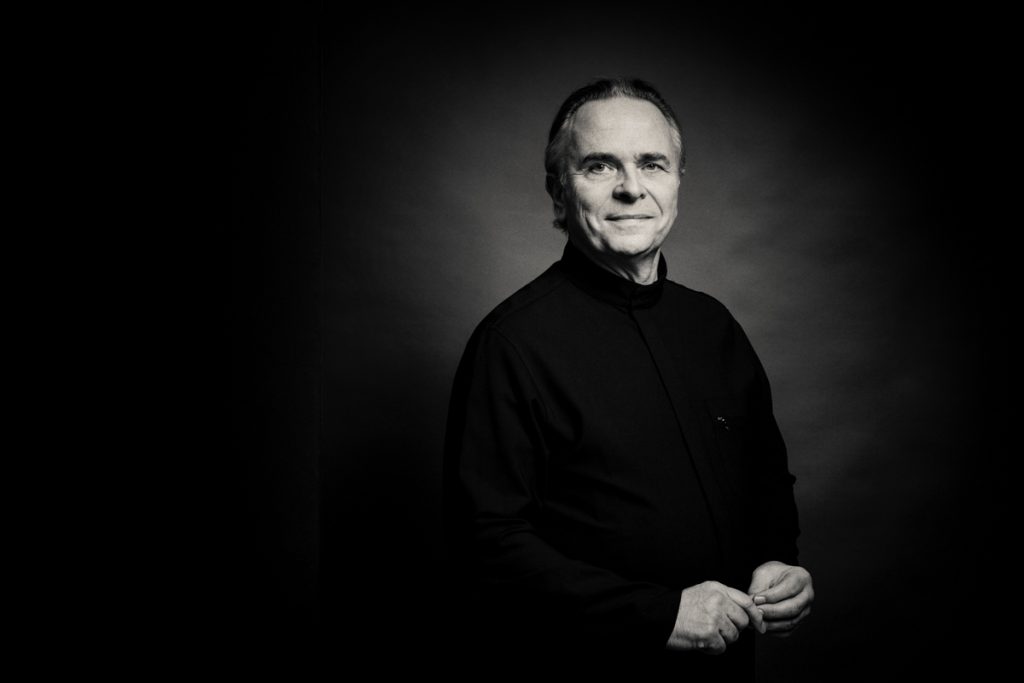Elder, NSO deliver energy without neglecting eternity in Mahler’s Ninth

Mark Elder conducted the National Symphony Orchestra in Mahler’s Symphony No. 9 Thursday night at the Kennedy Center. Photo: Halle Orchestra
Mark Elder last took the podium of the National Symphony Orchestra for a two-week residency in 2018. He was to have returned to Washington with Elgar’s Second Symphony, in a program planned for April 2021 but canceled. Instead he came to the Kennedy Center Thursday night with a rousing, expansive rendition of Mahler’s Symphony No. 9, last heard from the NSO under Christoph Eschenbach in 2015.
Elder is not particularly known for Mahler, having only recorded the Ninth—released in 2015 with Manchester’s Hallé Orchestra, where he remains principal conductor. In this performance with the NSO, Elder paced the work with an eye toward excitement in the middle movements and the heart turned to the infinite in the outer ones.
The heart-wrenching sadness of the Ninth, composed in 1908 and 1909, is centered on the loss of Mahler’s daughter, Maria Anna, who had died of scarlet fever, just age 5, in 1907. A motif from Beethoven’s Piano Sonata No. 26 (“Les adieux”) permeates the first movement, a three-note descending figure that opens the sonata, over which Beethoven wrote the word “Lebewohl” (Farewell).
Mahler used this motif repeatedly but left it incomplete, consisting of just the sighing first two notes, as if he could not complete the word. The NSO violin section’s melting tone gave a rich finish to the approach toward the movement’s first of three climaxes. The horn section responded with strength as the movement grew toward its goal, a somber funeral march section, where the deep bells made their only appearance.
Elder drew out the sweet return of the longing farewell motif, with poignant solo playing from the flute, violin, oboe, and clarinet in the final section. In an evanescent moment, the oboes sustained the last statement of this motif, which hung unresolved until it was finally completed, sotto voce, by the piccolo, plus harp and cellos on flageolet-tone harmonics, an otherworldly moment.
The second movement had a weighty elegance in the opening Ländler section, with the second violin section playing the chunky melody. The first violins took over the subsequent waltz, much faster and more raucous by contrast, and the movement teetered back and forth between these two poles. The Ländler’s return, deconstructed and spread out among viola and violin solos and the woodwinds, gave way to the waltz whirling out of control again, eventually fizzling out among pleasing bits for bassoon and contrabassoon.
Elder may have overstepped a bit in the Rondo-Burleske, with an agitated tempo that scrambled the complex counterpoint in a way that undermined the satire. Mahler intended the brutal subject, treated as an academic fugue, as a jab at his “brothers in Apollo,” one of the great musical diatribes against music critics, up there with Strauss’s in Ein Heldenleben. Amid the excessive neurotic energy created by the musicians, the trumpets were incandescent on their many perilously exposed solos.
After all that turbulence, the concluding Adagio hit like a cooling breeze. Here again, all the string sections sang the movement’s hymn-like melody with smoldering intensity. Elder’s careful managing of balances helped the winds and brass add judiciously to the string sound, building towering crescendi. If the tempo initially seemed a little too driven, this created space later for what Elder and the orchestra had planned for the final section.
In the final pages of the symphony, the orchestra wove a glowing aureole of delicate sound, setting up exquisite solo playing from principal cellist David Hardy. Reinforcing the message of farewell to his beloved daughter, Mahler even quoted one of the tunes from his own song cycle Kindertotenlieder in this section of the music. Pace Leonard Bernstein, centering the symphony on Mahler’s own health troubles, including hearing the composer’s “irregular heartbeat” in a syncopated theme in the first movement, seems to miss the point.
A Mahler symphony should contain multitudes, and in this performance the turmoil of the middle movements, alluding to the composer’s manic energy and battles with his critics in Vienna, seemed completely subsumed in his grief for the loss of his beloved Putzi, as he called her. By 1911, when Mahler was only 50 years old, he was buried in Vienna, and Maria Anna’s remains were moved from Maiernigg, where she had died, to rest near him.
The program will be repeated 8 p.m. Saturday and 3 p.m. Sunday. kennedy-center.org

Posted Feb 17, 2023 at 8:02 pm by John Harris
What a splendid Mahler 9, with conductor and orchestra together driving an inspired collaboration. The review matches my impressions, except: I thought the 3rd movement’s pace gave it a bold and slightly manic high-wire circus feel that made the final movement all the more poignant, reminding me of a wonderful recent recording by the Royal Concertgebouw.
Posted Feb 18, 2023 at 9:13 am by Patrick
Thank you so much for coverage of all the wonderful classical music in the DC/Baltimore area. Especially needed in light of Wash. Post pretty much abandoning such coverage.